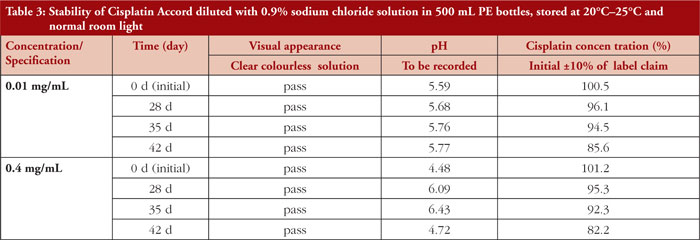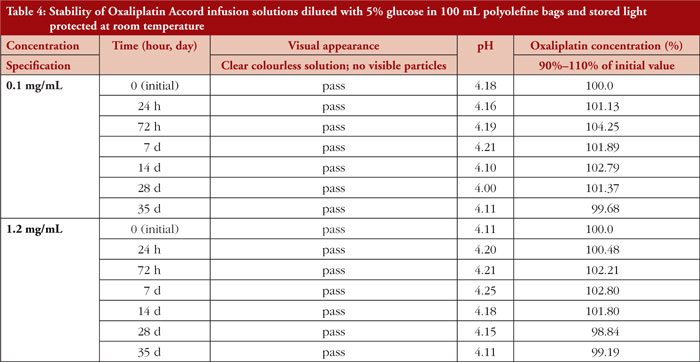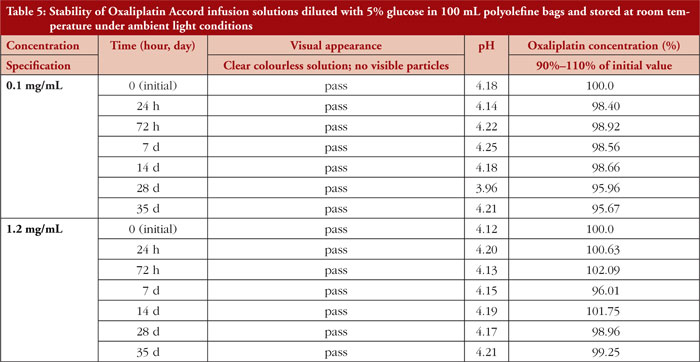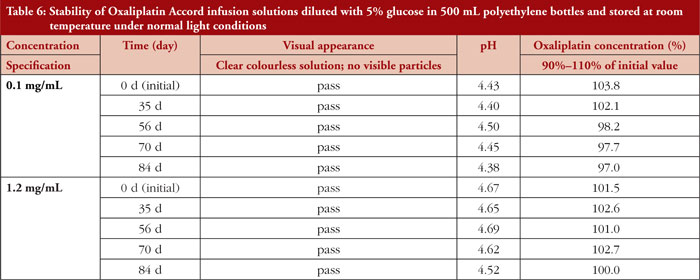Physicochemical stability of Oxaliplatin Accord 5 mg/mL in punctured original vials and after dilution with 5% glucose solution in polyethylene bottles and polyolefine bags
Published on 2024/09/11
Generics and Biosimilars Initiative Journal (GaBI Journal). 2024;13(2):99-102.
Author byline as per print journal: Irene Krämer, PhD; Frank Erdnuess, PhD; Judith Thiesen, PhD
|
Study objectives: To determine the physicochemical stability of Oxaliplatin Accord 5 mg/mL in punctured original vials and after dilution with 5% glucose solution in polyethylene (PE) bottles and polyolefine (PO) bags at different concentrations and different storage conditions. |
Submitted: 29 February 2024; Revised: 15 April 2024; Accepted: 26 April 2024; Published online first: 6 May 2024
Introduction
Oxaliplatin belongs to the platinum-containing antineoplastic agents. The organo-platinum complex consists of a platinum atom complexed with 1,2-diaminocyclohexane and a labile oxalate ligand. In physiological solutions, the oxalate ligand is displaced, and transient reactive aquo complexes are formed. These complexes induce inter- and intra-strand DNA crosslinks, leading to inhibition of transcription and replication, ultimately resulting in cell death.
Oxaliplatin Accord is approved for the adjuvant treatment of colon cancer and for the treatment of metastatic colorectal cancer, either alone or in combination with 5-fluorouracil and folinic acid [1]. Prior to administration, Oxaliplatin Accord 5 mg/mL concentrate must be diluted with 5% glucose solution. According to the Summary of Product Characteristics (SmPC), diluted infusion solutions are physicochemically stable for 48 hours when stored at 2°C–8°C and for 24 hours when stored at 25°C [1]. Since oxaliplatin is known to degrade rapidly in the presence of chloride ions (due to substitution of the oxalate ligand by two chloride ions), 0.9% sodium chloride solution is inappropriate as a vehicle solution [2, 3]. Several studies concerning stability of various oxaliplatin brand products have been published. The results indicate that the physicochemical stability of oxaliplatin solution concentrate lasts for 60 days when stored refrigerated [4]. Oxaliplatin diluted with a 5% glucose solution has been found to remain stable for up to 90 days when stored at room temperature or refrigerated [5-8].
Study objectives
To determine the physicochemical stability of Oxaliplatin Accord 5 mg/mL concentrate in punctured original vials, as well as after dilution with 5% glucose solution in polyethylene (PE) bottles and polyolefine (PO) bags (at nominal concentration 0.1 mg/mL, 1.2 mg/mL) under different storage conditions for a maximum period of 84 days.
Methods
Oxaliplatin test solutions were prepared under EU Class A conditions and in accordance with the principles of Good Manufacturing Practice. A total of five different test solutions were prepared using the European Medicines Agency (EMA) licensed Oxaliplatin Accord 5 mg/mL (batch numbers M12147, N13251, L07748). Undiluted Oxaliplatin Accord 5 mg/mL in punctured original vials was stored at room temperature without light protection for two weeks. Diluted test solutions in PO bags were stored refrigerated (2°C–8°C) with light protection or at room temperature (20°C–25°C) with and without light protection for up to 35 days. Diluted test solution in PE bottles were stored at room temperature under normal room light conditions for up to 84 days. Samples were taken and analysed initially (Day 0) and at predetermined time points. For detailed information, see Table 1.
The physical stability analysis comprised pH measurements (using a glass electrode calibrated with standard buffer solutions) and visual inspections under standard laboratory light for any changes in colour, clarity, or the presence of particulate matter.
Chemical stability was assessed via high-performance liquid chromatography (HPLC) analysis. The quantitative assay was validated for linearity of analytical response and acceptable precision. The stability-indicating nature of the assay was proven for non-specific degradation of the parent drug [9]. Acceptance criteria for test solutions were defined as within ±10% of the initially measured oxaliplatin concentration [9].
Results
Oxaliplatin Accord 5 mg/mL concentrate in punctured vials remained unchanged for 14 days when stored at room temperature under normal light conditions. Neither colour change, turbidity, nor visible particles were detected during visual inspection. Results of pH measurements showed only slight variations (less than 0.2 unit) during the observation period. Slight variations of oxaliplatin concentrations at different time points are related to assay variability, see Table 2.
Oxaliplatin test solutions, prepared with 5% glucose as a vehicle solution in PO bags, remained physicochemically stable over the entire 35-day test period, regardless of storage conditions. Measured values are given in Tables 3, 4 and 5.
Oxaliplatin test solutions prepared with 5% glucose as the vehicle solution in PE bottles remained physicochemically stable over the entire 84-day test period when stored at room temperature under normal room light, as shown in Table 6.
Conclusion
Oxaliplatin Accord solution concentrate 5 mg/mL remained physicochemically stable in the punctured original vials when stored at room temperature without light protection over the 14-day study period. Diluted oxaliplatin test solutions (0.1 mg/mL, 1.2 mg/mL) in a 5% glucose vehicle solution remained stable throughout the entire study period in both PO bags (35 days) and PE bottles (84 days), regardless of storage conditions (2°C–8°C, 20°C–25°C, with or without light protection). Hence, residues in punctured vials can be cost-effectively used for up to 14 days when stored at room temperature. Diluted oxaliplatin infusion solutions (0.1 mg/mL to 1.2 mg/mL) may be prepared in advance by pharmacy-based cytotoxic preparation units and used over a period of 35 days (PO bags) and even 84 days (PE bottles), preferably stored refrigerated.
Analysis was performed and documented by an accredited external laboratory. Results were carefully checked for plausibility and cautiously interpreted.
Funding sources
This study was funded by Accord Healthcare.
Competing interests: The authors Irene Krämer, Frank Erdnuess, and Judith Thiesen have no competing interests to declare.
Provenance and peer review: Not commissioned; externally peer reviewed.
Authors
Professor Irene Krämer, PhD
Frank Erdnuess, PhD
Judith Thiesen, PhD
Department of Pharmacy, University Medical Center of the Johannes Gutenberg University Mainz, 1 Langenbeckstraße, DE-55131 Mainz, Germany
References
1. Accord Healthcare Limited. Summary of product characteristics for Oxaliplatin Accord 5 mg/mL concentrate for solution for infusion. Available from: https://cdn.accord-healthcare.com/ie/public/pil/pil_oxaliplatin_website.pdf
2. Curis E, Provost K, Bouvet D, Nicolis I, Crauste-Manciet S, Brossard D, et al. Carboplatin and oxaliplatin decomposition in chloride medium, monitored by XAS. J Synchrotron Radiat. 2001;8(Pt 2):716-8.
3. Mehta AM, Van den Hoven JM, Rosing H, Hillebrand MJ, Nuijen B, Huitema ADR, et al. Stability of oxaliplatin in chloride-containing carrier solutions used in hyperthermic intraperitoneal chemotherapy. Int J Pharm. 2015;479(1):23-7.
4. Trojniak MP, Mazzi U, Palozzo AC, Morpurgo M, Franceschinis E, Realdon N, et al. Stability of lyophilised oxliplatin formulation in polyolefin infusion bags containing 5% dextrose injection. Eur J Hosp Pharm. 2014;21(1):45-8.
5. Krämer I, Sarakbi I, Thiesen J. Physikalisch-chemische Stabilität von Oxaliplatin-beta-Infusionslösungskonzentrat und Infusionslösungen in 5 % Glucose in Polyolefin-Infusionsbeuteln, Krankenhauspharmazie. 2017;38(7):334-40.
6. Trittler R, Heni J, Strehl E. Untersuchungen zur Haltbarkeit von Oxaliplatin (Eloxatine), Posterbeitrag, Jahrestagung der Deutschen Pharmazeutischen Gesellschaft, November 1998.
7. André P, Cisternino S, Roy AL, Chiadmi F, Schlatter J, Agranat P, et al. Stability of oxaliplatin in infusion bags containing 5% dextrose injection. Am J Health Syst Pharm. 2007;64(18):1950-4.
8. Junker A, Roy S, Desroches MC, Moussay C, Berhoune M, Bellanger A, et al. Stability of oxaliplatin solution. Ann Pharmacother. 2009;43(2):390-1.
9. Accord Healthcare Limited. Data for HPLC assay and acceptance criteria on file; 25-05-12 and 14-08-13.
|
Author for correspondence: Judith Thiesen, PhD, Department of Pharmacy, University Medical Center of the Johannes Gutenberg University Mainz, 1 Langenbeckstraße, DE-55131 Mainz, Germany |
Disclosure of Conflict of Interest Statement is available upon request.
Copyright © 2024 Pro Pharma Communications International
Permission granted to reproduce for personal and non-commercial use only. All other reproduction, copy or reprinting of all or part of any ‘Content’ found on this website is strictly prohibited without the prior consent of the publisher. Contact the publisher to obtain permission before redistributing.








